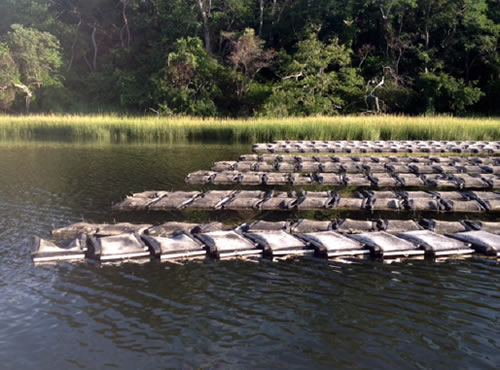The Pleasant Bay Alliance: Going Far by Going Together
November 2020
"If you want to go fast, go alone. If you want to go far, go together." The Pleasant Bay Alliance has taken the lesson from this African proverb to heart. Created from a shared commitment to nutrient reduction efforts, the Cape Cod towns of Brewster, Chatham, Harwich and Orleans learned early on in their reduction efforts that working together would be easier than going it alone. For more than two decades, the Alliance has been cooperating on nutrient issues, including water quality monitoring and modeling that led the EPA to issue Total Maximum Daily Load values (TMDLs) for Total Nitrogen across 19 segments throughout Pleasant Bay. It was these efforts that led the Alliance to work with the MA Department of Environmental Protection to establish one of the first regional watershed permits to allow for the creation of a shared management plan for nutrient reduction.
In addition to standard nutrient reduction efforts such as infrastructure upgrades or sewer expansion, the watershed permit opened the door for new and innovative nutrient reduction technologies such as the installation of permeable reactive barriers, the use of golf course fertigation (uptake of nitrogen from groundwater through irrigation), the installation of innovative and alternative (I/A) septic systems, nitrogen bioextraction via shellfish aquaculture, and the potential for nitrogen reduction credit trading between towns. While towns were interested in these promising technologies, pilot projects were needed to determine how well they would work. Funding for these pilots quickly became an issue due to tight town budgets.
Through partnership with the Southeast New England Program (SNEP), the Pleasant Bay Alliance was able to test many of these new and innovative solutions while continuing to work toward their nutrient reduction targets for the first phase of their 20-year watershed permit. In 2018, SNEP funding enabled the Alliance to study the municipal requirements of I/A septic system installation; develop a monitoring framework to determine shellfish aquaculture efficacy in nutrient extraction; launch a nutrient-trading demonstration project; and update the 15-year-old ecological model serving as the underpinning for the initial TMDL designation.

"The funding from the first SNEP grant gave us a tremendous boost in our ability to make headway on some very promising and innovative approaches that the towns otherwise would not have had the resources to pursue," said Carole Ridley, a representative of the Pleasant Bay Alliance. The Alliance was recently awarded a second round of SNEP funding that will enable them to apply their updated ecological model and further test the efficacy of these innovative systems across new scenario plans in the region. Additionally, they will begin to explore the potential for accumulating credit toward TMDL compliance for nitrogen reductions achieved through stormwater management, which is responsible for 9% of watershed nitrogen load.
The Pleasant Bay Alliance is on track to meet the targets set in the first phase of their watershed permit. Their goal is to reduce total Nitrogen load by at least 17,700 kg-N/yr over the 20-year permit.
For more information on The Pleasant Bay Alliance, please contact Carole Ridley (cr@ridleyandassociates.com) or visit their website at https://pleasantbay.org
